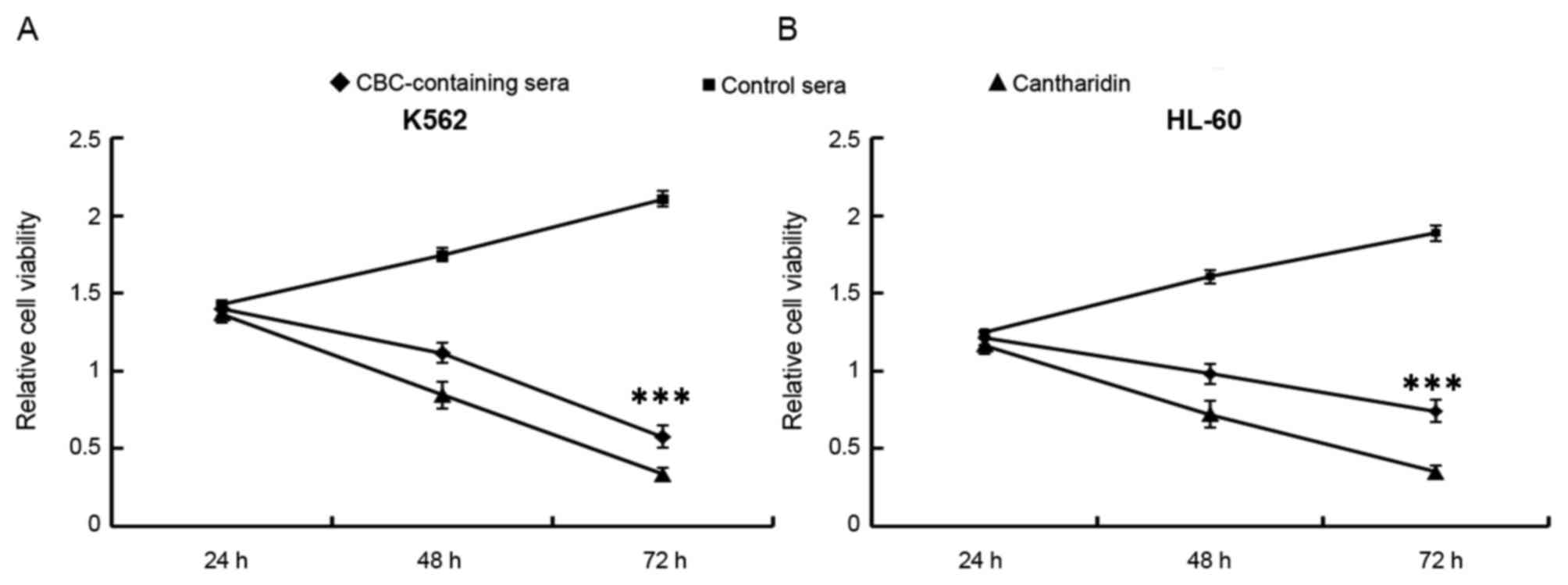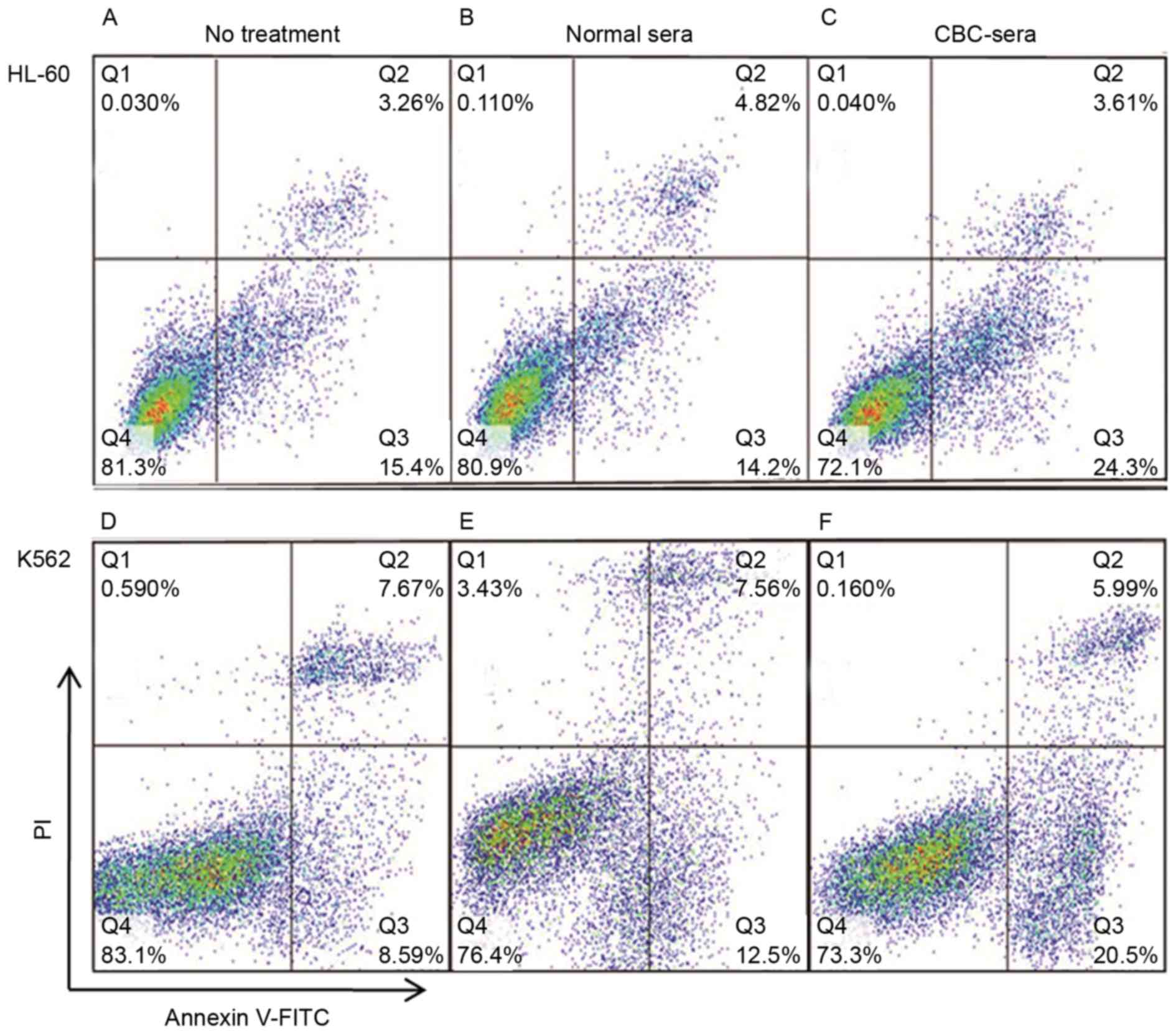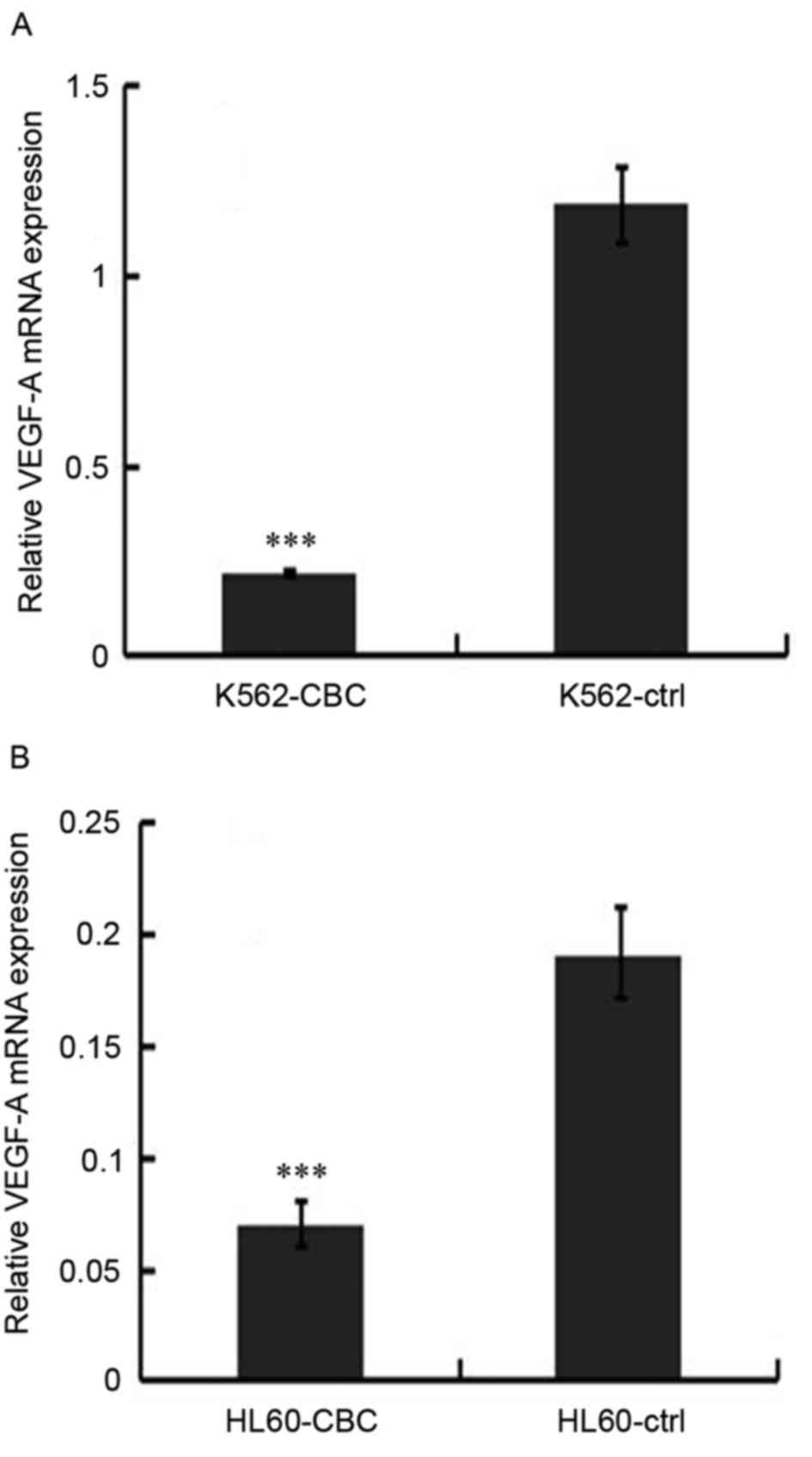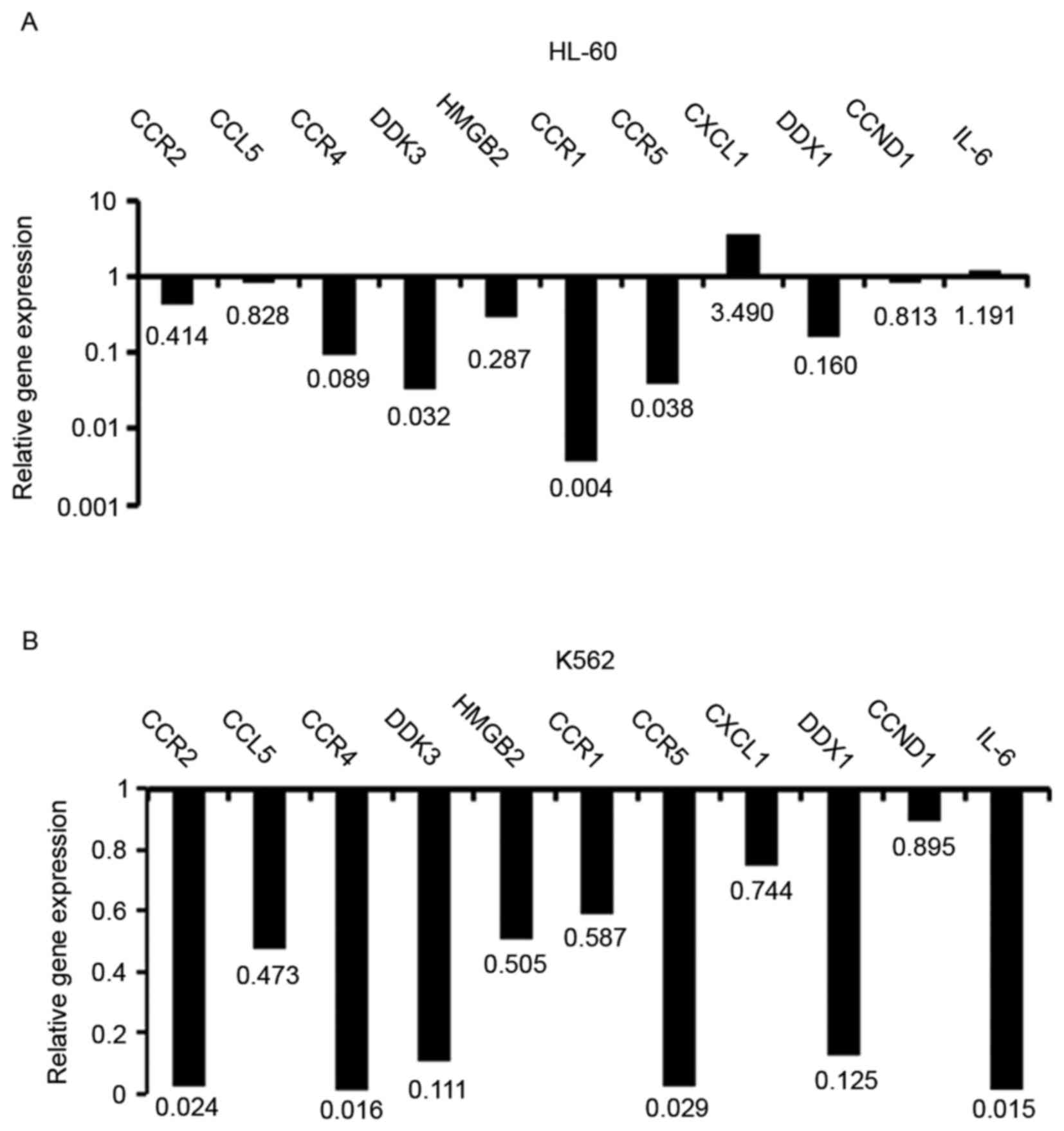|
1
|
Vardiman JW: The World Health Organization
(WHO) classification of tumors of the hematopoietic and lymphoid
tissues: An overview with emphasis on the myeloid neoplasms. Chem
Biol Interact. 184:16–20. 2010. View Article : Google Scholar : PubMed/NCBI
|
|
2
|
Li FF, Yi S, Wen L, He J, Yang LJ, Zhao J,
Zhang BP, Cui GH and Chen Y: Oridonin induces NPM mutant protein
translocation and apoptosis in NPM1c+ acute myeloid leukemia cells
in vitro. Acta Pharmacol Sin. 35:806–813. 2014. View Article : Google Scholar : PubMed/NCBI
|
|
3
|
Hu XM, Yuan B, Tanaka S, Song MM, Onda K,
Tohyama K, Zhou AX, Toyoda H and Hirano T: Arsenic
disulfide-triggered apoptosis and erythroid differentiation in
myelodysplastic syndrome and acute myeloid leukemia cell lines.
Hematology. 19:352–360. 2014. View Article : Google Scholar : PubMed/NCBI
|
|
4
|
Man S, Gao W, Wei C and Liu C: Anticancer
drugs from traditional toxic Chinese medicines. Phytother Res.
26:1449–1465. 2012.PubMed/NCBI
|
|
5
|
Liu D and Chen Z: The effects of
cantharidin and cantharidin derivates on tumour cells. Anticancer
Agents Med Chem. 9:392–396. 2009. View Article : Google Scholar : PubMed/NCBI
|
|
6
|
Xu H, Wu Q, Peng C and Zhou L: Study on
the antiviral activity of San Huang Yi Gan Capsule against
hepatitis B virus with seropharmacological method. BMC Complement
Altern Med. 13:2392013. View Article : Google Scholar : PubMed/NCBI
|
|
7
|
Livak KJ and Schmittgen TD: Analysis of
relative gene expression data using real-time quantitative PCR and
the 2(−Delta Delta C(T)) Method. Methods. 25:402–408. 2001.
View Article : Google Scholar : PubMed/NCBI
|
|
8
|
Bochu W, Liancai Z and Qi C: Primary study
on the application of Serum Pharmacology in Chinese traditional
medicine. Colloids Surf B Biointerfaces. 43:194–197. 2005.
View Article : Google Scholar : PubMed/NCBI
|
|
9
|
Wu Q, Rong X, Huang P, Han J and Xu H:
Study on inhibitory actions of san huang yi gan capsule (SHYGC) on
HBeAg with seropharmacological method. Zhong Yao Cai. 23(2):
75–278. 2000.(In Chinese).
|
|
10
|
Zhang YH, Liu JT, Wen BY and Liu N:
Mechanisms of inhibiting proliferation of vascular smooth muscle
cells by serum of rats treated with Dahuang Zhechong pill. J
Ethnopharmacol. 124:125–129. 2009. View Article : Google Scholar : PubMed/NCBI
|
|
11
|
Han SB, Yoon YD, Ahn HJ, Lee HS, Lee CW,
Yoon WK, Park SK and Kim HM: Toll-like receptor-mediated activation
of B cells and macrophages by polysaccharide isolated from cell
culture of Acanthopanax senticosus. Int Immunopharmacol.
3:1301–1312. 2003. View Article : Google Scholar : PubMed/NCBI
|
|
12
|
Wang GS: Medical uses of mylabris in
ancient China and recent studies. J Ethnopharmacol. 26:147–162.
1989. View Article : Google Scholar : PubMed/NCBI
|
|
13
|
Tagwireyi D, Ball DE, Loga PJ and Moyo S:
Cantharidin poisoning due to ‘Blister beetle’ ingestion. Toxicon.
38:1865–1869. 2000. View Article : Google Scholar : PubMed/NCBI
|
|
14
|
Graziano MJ, Pessah IN, Matsuzawa M and
Casida JE: Partial characterization of specific cantharidin binding
sites in mouse tissues. Mol Pharmacol. 33:706–712. 1988.PubMed/NCBI
|
|
15
|
Peng F, Wei YQ, Tian L, Yang L, Zhao X, Lu
Y, Mao YQ, Kan B, Lei S, Wang GS, et al: Induction of apoptosis by
norcantharidin in human colorectal carcinoma cell lines:
Involvement of the CD95 receptor/ligand. J Cancer Res Clin Oncol.
128:223–230. 2002. View Article : Google Scholar : PubMed/NCBI
|
|
16
|
Huang Y, Liu Q, Liu K, Yagasaki K and
Zhang G: Suppression of growth of highly-metastatic human breast
cancer cells by norcantharidin and its mechanisms of action.
Cytotechnology. 59:2092009. View Article : Google Scholar : PubMed/NCBI
|
|
17
|
Fan YZ, Fu JY, Zhao ZM and Chen CQ:
Inhibitory effect of norcantharidin on the growth of human
gallbladder carcinoma GBC-SD cells in vitro. Hepatobiliary Pancreat
Dis Int. 6:72–80. 2007.PubMed/NCBI
|
|
18
|
Huan SK, Lee HH, Liu DZ, Wu CC and Wang
CC: Cantharidin-induced cytotoxicity and cyclooxygenase 2
expression in human bladder carcinoma cell line. Toxicology.
223:136–143. 2006. View Article : Google Scholar : PubMed/NCBI
|
|
19
|
Dorn DC, Kou CA, Png KJ and Moore MA: The
effect of cantharidins on leukemic stem cells. Int J Cancer.
124:2186–2199. 2009. View Article : Google Scholar : PubMed/NCBI
|
|
20
|
Yi SN, Wass J, Vincent P and Iland H:
Inhibitory effect of norcantharidin on K562 human myeloid leukemia
cells in vitro. Leuk Res. 15:883–886. 1991. View Article : Google Scholar : PubMed/NCBI
|
|
21
|
Schmeda-Hirschmann G, Villaseñor-García
MM, Lozoya X and Puebla-Pérez AM: Immunomodulatory activity of
Chilean Cyttaria species in mice with L5178Y lymphoma. J
Ethnopharmacol. 77:253–257. 2001. View Article : Google Scholar : PubMed/NCBI
|
|
22
|
Schmolz MW, Sacher F and Aicher B: The
synthesis of Rantes, G-CSF, IL-4, IL-5, IL-6, IL-12 and IL-13 in
human whole-blood cultures is modulated by an extract from
Eleutherococcus senticosus L. roots. Phytother Res. 15:268–270.
2001. View
Article : Google Scholar : PubMed/NCBI
|
|
23
|
Jeong HJ, Koo HN, Myung NI, Shin MK, Kim
JW, Kim DK, Kim KS, Kim HM and Lee YM: Inhibitory effects of mast
cell-mediated allergic reactions by cell cultured Siberian Ginseng.
Immunopharmacol Immunotoxicol. 23:107–117. 2001. View Article : Google Scholar : PubMed/NCBI
|
|
24
|
Yi JM, Kim MS, Seo SW, Lee KN, Yook CS and
Kim HM: Acanthopanax senticosus root inhibits mast cell-dependent
anaphylaxis. Clin Chim Acta. 312:163–168. 2001. View Article : Google Scholar : PubMed/NCBI
|
|
25
|
Yoon TJ, Yoo YC, Lee SW, Shin KS, Choi WH,
Hwang SH, Ha ES, Jo SK, Kim SH and Park WM: Anti-metastatic
activity of Acanthopanax senticosus extract and its possible
immunological mechanism of action. J Ethnopharmacol. 93:247–253.
2004. View Article : Google Scholar : PubMed/NCBI
|
|
26
|
Wang Q, Wang Y, Liu R, Yan X, Li Y, Fu H,
Bi K and Li Q: Comparison of the effects of Mylabris and
Acanthopanax senticosus on promising cancer marker polyamines in
plasma of a Hepatoma-22 mouse model using HPLC-ESI-MS. Biomed
Chromatogr. 27:208–215. 2013. View
Article : Google Scholar : PubMed/NCBI
|
|
27
|
Chang C, Zhu YQ, Mei JJ, Liu SQ and Luo J:
Involvement of mitochondrial pathway in NCTD-induced cytotoxicity
in human hepG2 cells. J Exp Clin Cancer Res. 29:1452010. View Article : Google Scholar : PubMed/NCBI
|
|
28
|
Zheng LH, Bao YL, Wu Y, Yu CL, Meng X and
Li YX: Cantharidin reverses multidrug resistance of human hepatoma
HepG2/ADM cells via down-regulation of P-glycoprotein expression.
Cancer Lett. 272:102–109. 2008. View Article : Google Scholar : PubMed/NCBI
|
|
29
|
Avramis IA, Kwock R and Avramis VI:
Taxotere and vincristine inhibit the secretion of the angiogenesis
inducing vascular endothelial growth factor (VEGF) by wild-type and
drug-resistant human leukemia T-cell lines. Anticancer Res.
21:2281–2286. 2001.PubMed/NCBI
|
|
30
|
Katoh O, Tauchi H, Kawaishi K, Kimura A
and Satow Y: Expression of the vascular endothelial growth factor
(VEGF) receptor gene, KDR, in hematopoietic cells and inhibitory
effect of VEGF on apoptotic cell death caused by ionizing
radiation. Cancer Res. 55:5687–5692. 1995.PubMed/NCBI
|
|
31
|
Ye X, Wang LJ, Lin MF and Ding W: The
clinical significance of angiogenesis in the bone marrow of acute
leukemia patients. Zhonghua Nei Ke Za Zhi. 42:486–489. 2003.(In
Chinese). PubMed/NCBI
|
|
32
|
Ye XJ and Lin MF: Homoharringtonine
induces apoptosis of endothelium and down-regulates VEGF expression
of K562 cells. J Zhejiang Univ Sci. 5:230–234. 2004. View Article : Google Scholar : PubMed/NCBI
|
|
33
|
Aggarwal BB, Shishodia S, Sandur SK,
Pandey MK and Sethi G: Inflammation and cancer: How hot is the
link? Biochem Pharmacol. 72:1605–1621. 2006. View Article : Google Scholar : PubMed/NCBI
|
|
34
|
Gasparini C, Celeghini C, Monasta L and
Zauli G: NF-κB pathways in hematological malignancies. Cell Mol
Life Sci. 71:2083–2102. 2014. View Article : Google Scholar : PubMed/NCBI
|
|
35
|
Candido J and Hagemann T: Cancer-related
inflammation. J Clin Immunol. 33:(Suppl 1). S79–S84. 2013.
View Article : Google Scholar : PubMed/NCBI
|















